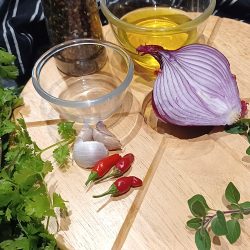Your Secret Weapon for Flavour
If you’re looking to elevate grilled meats, roasted vegetables, or even sandwiches, this cilantro chimichurri is the flavor bomb you’ve been waiting for. It comes together in minutes and tastes even better after a little rest, making it the perfect make-ahead sauce to keep on hand.
Chimichurri with a Cilantro-First Vibe
Traditionalists, look away—this chimichurri is for the cilantro lovers! We’ve doubled down on fresh coriander, added a little red onion for balance, and kept the punchy vinegar and garlic that make chimichurri so craveable. It’s not what your Argentine abuela would make… but it is delicious.
Traditional Sauces You Should Know
Discover the sauces that inspired (and influenced) chimichurri around the world.
Your coriander chimichurri may be a twist on the classic, but it’s rooted in a rich tradition of bold, herb-forward sauces from Latin America and beyond. Here’s a quick guide to some of the most iconic ones:
Chimichurri (Argentina & Uruguay)
Base ingredients: Parsley, garlic, oregano, olive oil, vinegar
Flavor profile: Herby, garlicky, tangy with optional chili heat
How to use it: The original chimichurri. Serve with grilled steak (asado!), sausages, or roasted vegetables. Traditionally kept chunky and spooned over meats right before serving.
📝 Tip: Want a red version? Add sweet paprika or chopped roasted red peppers for chimichurri rojo.
Aji Verde (Peru)
Base ingredients: Cilantro, aji amarillo (or jalapeños), garlic, lime, mayo or cheese
Flavor profile: Creamy, spicy, citrusy
How to use it: This is the magic sauce that turns Peruvian grilled chicken (pollo a la brasa) into something unforgettable. Also amazing with fries or rice bowls.
📝 Tip: If you can’t find aji amarillo, blend in yellow bell pepper and fresh chili for color and heat.
Mojo (Cuba & Canary Islands)
Base ingredients: Garlic, sour orange (or lime), olive oil, cumin
Flavor profile: Garlicky, citrusy, earthy
How to use it: Excellent as a marinade or finishing sauce for pork (especially lechon), grilled seafood, or starchy sides like yuca and plantains.
📝 Tip: No sour orange? Mix orange and lime juice for a near-perfect swap.
Pebre (Chile)
Base ingredients: Cilantro, tomatoes, garlic, onion, vinegar, chili
Flavor profile: Chunky, zesty, tomato-fresh
How to use it: Served like a salsa at the table with crusty bread (Marquetta), grilled meats, or empanadas. Pebre is all about bold freshness.
📝 Tip: For a heartier texture, hand-chop everything and let it sit for an hour before serving.
🌶️ Salsa Criolla (Argentina & Peru)
Base ingredients: Cilantro, tomatoes, garlic, onion, vinegar, chili
Flavor profile: Chunky, zesty, tomato-fresh
How to use it: Served like a salsa at the table with crusty bread (Marquetta), grilled meats, or empanadas. Pebre is all about bold freshness.
📝 Tip: For a heartier texture, hand-chop everything and let it sit for an hour before serving.
✨ Beyond Latin America: Global Cousins
Your coriander chimichurri has a few flavour cousins worth mentioning:
- Zhoug (Middle East) – A spicy green sauce with cilantro, garlic, and green chili
- Gremolata (Italy) – A dry mix of parsley, garlic, and lemon zest used to top meats
- Green Chutney (India) – Made with coriander, mint, green chili, and lemon juice
These sauces all bring bold herbaceousness in their own way—and can totally inspire your next twist on chimichurri.

Coriander Chimichurri Sauce
Equipment
- Blender or Food Processor or chop by hand for a rustic texture
Ingredients
- 2 cups coriander stems and leaves, about 2 large bunches
- 3 cloves garlic peeled
- ¼ small red onion peeled and chopped or use shollot for milder flavour
- 2 tsp dried oregano or ¼ handful fresh
- 2 tbsp white wine vinegar
- ½ cup olive oil
- salt and black pepper to taste
Instructions
- In a blender or food processor, combine coriander, garlic, onion, chili flakes, oregano, vinegar, and half the olive oil.
- Pulse a few times until you get your desired texture (I like it a bit chunky, not too smooth).
- Stir in the remaining olive oil by hand for a more balanced texture.
- Transfer to a jar and let it sit at room temperature for at least 20 minutes before serving.
